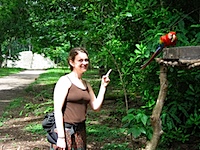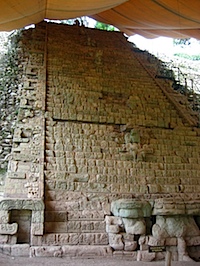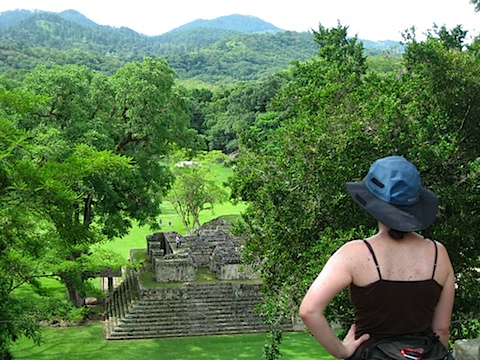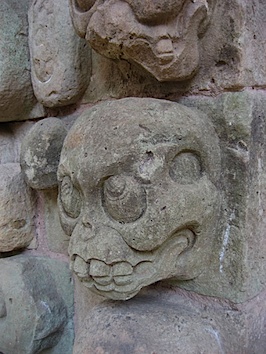 We took a little side trip to Honduras today, to see something of Central America besides Guatemala. This trip was in some ways similar to visiting Illinois from Indiana: hard to tell the difference, unless you read the patch on the policeman’s shoulder. Same language, same accent, same poverty, same natural beauty. The money is different (lempira instead of quetzales), so we had to change some so we could get a room for the night. Or so we thought; turns out that most everyone we met takes dollars. At first, we thought it was because they have heavy tourist traffic, but now I feel it might be because dollars are more stable. If you are a Honduran businessman, having some dollars hidden away could be a much more secure savings than holding onto the local coin. The exchange rate is also more favorable if one brings dollars instead of quetzales (18 lem to the dollar; 8 Q to the dollar), so our tourist dollar goes farther. Thank goodness we still had a few greenbacks left over from our last visit to the US. At the end of our trip, we brought back some leftover lempira to give to the nieces and nephews as “funny money”, much like my uncle Bill used to give to us when he came back from his various oddball assignments overseas. What WAS the currency in Botswana, anyways? I can’t remember.
We took a little side trip to Honduras today, to see something of Central America besides Guatemala. This trip was in some ways similar to visiting Illinois from Indiana: hard to tell the difference, unless you read the patch on the policeman’s shoulder. Same language, same accent, same poverty, same natural beauty. The money is different (lempira instead of quetzales), so we had to change some so we could get a room for the night. Or so we thought; turns out that most everyone we met takes dollars. At first, we thought it was because they have heavy tourist traffic, but now I feel it might be because dollars are more stable. If you are a Honduran businessman, having some dollars hidden away could be a much more secure savings than holding onto the local coin. The exchange rate is also more favorable if one brings dollars instead of quetzales (18 lem to the dollar; 8 Q to the dollar), so our tourist dollar goes farther. Thank goodness we still had a few greenbacks left over from our last visit to the US. At the end of our trip, we brought back some leftover lempira to give to the nieces and nephews as “funny money”, much like my uncle Bill used to give to us when he came back from his various oddball assignments overseas. What WAS the currency in Botswana, anyways? I can’t remember.
Besides the novelty of seeing a new country, the real reason for our trip was to check out the Mayan ruins at Copán. We heard about them when we visited Tikal and El Mirador, and although the architecture at those two sites is larger and more grandiose, the sculpture and engravings at Copán leave the others far behind. It is generally considered the best site in the world for Mayan sculpture. Dozens of extremely elaborate carved stellae dot the site, as well as altars, capstones, and other stonework. All of the stellae are dated to the exact year they were built, since the Mayans are both obsessed with carving the date into everything, and also contrived one of the most sophisticated astrological calendars in history. Good news for the archaeologists!
 Copán was a major Mayan capitol in the 600s and 700s, operating later than Tikal and El Mirador, much farther to the north. To see these amazing works of engineering (highways, plazas, ball courts) backed up by such an elaborate infrastructure of culture and trade boggles my mind… especially when I think about Europe at the time, cowering in their tiny wooden palisades against the rampaging Vikings. Here is a picture of the pride of Copán: the grand staircase. The stairs climb the entire side of a pyramid, and each riser is carved with elaborate hieroglyphs depicting the history of the city in over 2,000 separate images.
Copán was a major Mayan capitol in the 600s and 700s, operating later than Tikal and El Mirador, much farther to the north. To see these amazing works of engineering (highways, plazas, ball courts) backed up by such an elaborate infrastructure of culture and trade boggles my mind… especially when I think about Europe at the time, cowering in their tiny wooden palisades against the rampaging Vikings. Here is a picture of the pride of Copán: the grand staircase. The stairs climb the entire side of a pyramid, and each riser is carved with elaborate hieroglyphs depicting the history of the city in over 2,000 separate images.
But all good things must come to an end, and in the early 800s, the city died out. Archaeologists sampled gravesites and looked at bone development, age at death, and disease evidence. They found that like so many other places in history (Tikal, El Mirador, Mesa Verde), the culture grew too big for its britches. Overfarming and deforestation lead to extreme soil depletion, unchecked erosion, lost water resources, and eventual social collapse. By the time the Spaniards arrived in the 1500s, this former city of 30,000 was inhabited by five families.
This got Emily and I talking about how these things apply to modern life. We face many similar problems today: our freshwater resources in North America are running low, deserts in Africa are expanding, the rainforests in South America are disappearing daily, and the polar icecaps are smaller than they’ve been in millennia. Add this to a still-unchecked population explosion, and it doesn’t take a genius to realize that some time soon, we’re going to run out of food/water/air to go around. You know the old saying, “Those who don’t learn from history are doomed to repeat it.” But despite all this doom and gloom, I remain optimistic, because we have something all these other ancient civilizations didn’t: communication. If one or two people in ancient Copán saw the writing on the wall, they could shout from a soapbox for a while but no one would take them seriously, if they were heard at all. In contrast, we now have internet and newsmedia and so forth, so as the situation worsens, more and more people are going to become aware of the problem, and (hopefully) we can get organized to take action before it becomes critical. Furthermore, we can draw scientists and thinkers to solve our problems from a world-wide pool of millions. I think we’ll be OK.

